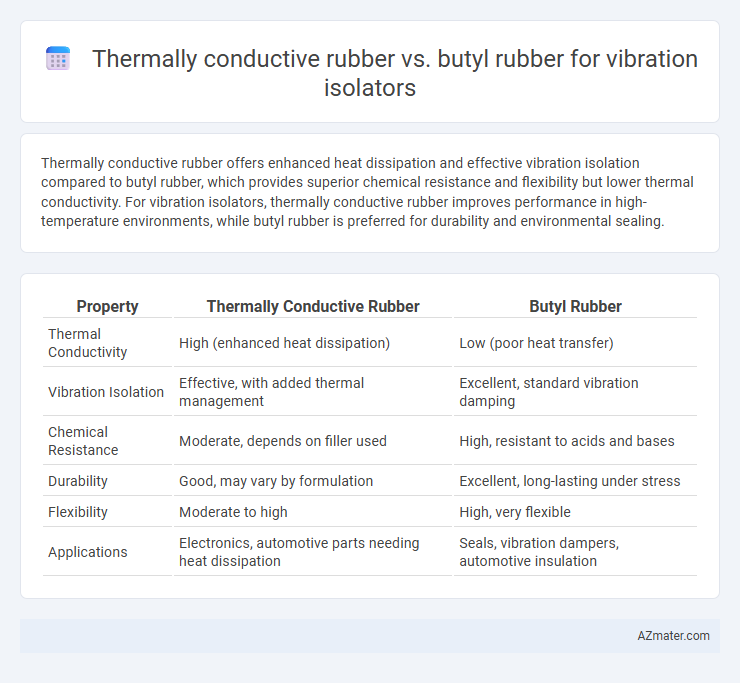Thermally conductive rubber offers enhanced heat dissipation and effective vibration isolation compared to butyl rubber, which provides superior chemical resistance and flexibility but lower thermal conductivity. For vibration isolators, thermally conductive rubber improves performance in high-temperature environments, while butyl rubber is preferred for durability and environmental sealing.
Table of Comparison
| Property | Thermally Conductive Rubber | Butyl Rubber |
|---|---|---|
| Thermal Conductivity | High (enhanced heat dissipation) | Low (poor heat transfer) |
| Vibration Isolation | Effective, with added thermal management | Excellent, standard vibration damping |
| Chemical Resistance | Moderate, depends on filler used | High, resistant to acids and bases |
| Durability | Good, may vary by formulation | Excellent, long-lasting under stress |
| Flexibility | Moderate to high | High, very flexible |
| Applications | Electronics, automotive parts needing heat dissipation | Seals, vibration dampers, automotive insulation |
Introduction to Vibration Isolators
Vibration isolators reduce mechanical vibrations and protect sensitive equipment by absorbing and dissipating energy. Thermally conductive rubber combines vibration damping with efficient heat dissipation, making it ideal for applications requiring thermal management. Butyl rubber offers excellent vibration isolation due to its high damping properties and resistance to gases and chemicals but lacks thermal conductivity advantages.
Overview of Thermally Conductive Rubber
Thermally conductive rubber is engineered to efficiently transfer heat while maintaining flexibility, making it ideal for vibration isolators in electronic and automotive applications where heat dissipation is critical. Unlike butyl rubber, which primarily offers excellent sealing and chemical resistance but poor thermal conductivity, thermally conductive rubber incorporates fillers such as boron nitride or aluminum oxide to enhance thermal transfer capabilities. This combination of thermal efficiency and vibration damping reduces overheating risks and improves device longevity.
Properties of Butyl Rubber
Butyl rubber exhibits excellent vibration isolation properties due to its high damping capacity, low compression set, and superior resistance to heat, chemicals, and ozone. Its low permeability to gases and moisture enhances durability in vibration isolators used in harsh environments. Although thermally conductive rubber offers better heat dissipation, butyl rubber's superior elasticity and aging resistance make it ideal for long-lasting vibration dampening applications.
Thermal Conductivity Comparison
Thermally conductive rubber exhibits significantly higher thermal conductivity, typically ranging from 1 to 5 W/m*K, compared to butyl rubber, which usually has a low thermal conductivity around 0.16 W/m*K. This superior thermal conduction enables thermally conductive rubber to effectively dissipate heat in vibration isolators, improving performance in high-temperature environments. Butyl rubber's low thermal conductivity limits heat transfer, making it less suitable for applications where thermal management alongside vibration isolation is critical.
Vibration Damping Performance
Thermally conductive rubber exhibits superior vibration damping performance compared to butyl rubber due to its enhanced ability to dissipate vibrational energy through its specialized filler materials, such as graphite or boron nitride. Butyl rubber, while offering excellent air and gas impermeability, generally provides lower damping efficiency because of its higher stiffness and lower energy absorption capacity. The optimized viscoelastic properties of thermally conductive rubber make it more effective in reducing vibration transmission and improving isolator longevity in high-frequency applications.
Durability and Environmental Resistance
Thermally conductive rubber offers superior durability and environmental resistance compared to butyl rubber, maintaining performance under high temperatures and extended exposure to UV radiation and chemicals. Butyl rubber provides excellent resistance to ozone, moisture, and aging but tends to degrade faster under thermal stress and harsh chemical environments. Choosing thermally conductive rubber enhances vibration isolator lifespan in demanding industrial settings with elevated thermal and chemical challenges.
Applications in Industrial Settings
Thermally conductive rubber offers superior heat dissipation properties, making it ideal for vibration isolators in industrial machinery where both thermal management and vibration reduction are critical, such as in electronics manufacturing and automotive assembly lines. Butyl rubber excels in chemical resistance and impermeability, providing durable vibration isolation in harsh environments like chemical processing plants and oil refineries where exposure to oils and solvents is frequent. Selecting between these materials depends on the need for thermal conductivity versus chemical resilience in specific industrial applications.
Cost-Effectiveness and Availability
Thermally conductive rubber offers enhanced heat dissipation properties crucial for high-performance vibration isolators, but it often comes at a higher cost and limited availability compared to butyl rubber. Butyl rubber provides excellent vibration damping with superior chemical resistance and is widely available at a lower cost, making it a cost-effective choice for standard vibration isolation applications. Considering budget constraints and supply chain reliability, butyl rubber remains the preferred material for most commercial vibration isolators, while thermally conductive rubber is suited for specialized environments requiring thermal management.
Installation and Maintenance Considerations
Thermally conductive rubber offers superior heat dissipation properties, reducing the risk of thermal degradation during installation and maintenance of vibration isolators, whereas butyl rubber excels in chemical resistance but may require additional heat management. Installation of thermally conductive rubber isolators demands careful handling to maintain the integrity of the conductive pathways, while butyl rubber components are generally easier to manipulate due to their elasticity but can degrade faster under high temperatures. Maintenance for thermally conductive rubber focuses on preserving thermal conductivity and inspecting for internal heat damage, contrasting with butyl rubber's need for monitoring chemical exposure and potential swelling or cracking over time.
Choosing the Optimal Rubber for Vibration Isolation
Thermally conductive rubber offers superior heat dissipation and maintains consistent mechanical properties under varying temperatures, making it ideal for vibration isolators in high-heat environments. Butyl rubber provides excellent airtightness and chemical resistance but has lower thermal conductivity and may degrade under prolonged thermal stress, reducing its effectiveness in vibration damping where heat buildup occurs. Selecting the optimal rubber for vibration isolation depends on balancing thermal management needs with vibration attenuation, where thermally conductive rubber often outperforms butyl rubber in applications requiring both heat dissipation and vibration control.

Infographic: Thermally conductive rubber vs Butyl rubber for Vibration isolator
 azmater.com
azmater.com